Optimization of Conditions for a Freeze-Dried Restructured Strawberry Block by Adding Guar Gum, Pectin and Gelatin
Abstract
1. Introduction
2. Results and Discussion
2.1. Analysis of Variance of the Regression Models
2.2. Influence of the Amount of Edible Gum Added on the Chewiness Evaluation
2.3. Influence of the Amount of Edible Gum Added on the Hardness Evaluation
2.4. Influence of the Amount of Edible Gum Added on the Organoleptic Evaluation
2.5. The Optimal Combination Addition and Verification
2.6. Comparison of the Untreated Samples and the Samples Treated with the Optimal Combination Addition
2.6.1. Moisture Content, Yield, Chewiness, Hardness, the Total Color Difference, Organoleptic Evaluations, and Pore Structure Analysis
2.6.2. Volatile Compounds Analysis
2.6.3. Microstructural Analysis
3. Materials and Methods
3.1. Materials
3.2. The Preparation of Freeze-Dried Restructured Strawberry Blocks
3.3. Response Surface Methodology for the Optimization of Compound Edible Gums Addition
3.4. Determination of Moisture Content
3.5. Determination of Yield
3.6. Determination of Texture Profile Analysis
3.7. Determination of Puncture
3.8. Determination of Total Color Difference
3.9. Determination of Organoleptic Evaluation
3.10. Determination of Volatile Compounds
3.11. Determination of Microstructure
3.12. Determination of Pore Structure
3.13. Statistical Analysis
4. Conclusions
Author Contributions
Funding
Institutional Review Board Statement
Informed Consent Statement
Data Availability Statement
Acknowledgments
Conflicts of Interest
References
- Giampieri, F.; Forbes-Hernandez, T.Y.; Gasparrini, M.; Alvarez-Suarez, J.M.; Afrin, S.; Bompadre, S.; Quiles, J.; Bruno, M.; Battino, M. Strawberry as a health promoter: An evidence based review. Food Funct. 2015, 6, 1386–1398. [Google Scholar] [CrossRef] [PubMed]
- Urün, I.; Attar, S.H.; Sönmez, D.A.; Gündeşli, M.A.; Ercişli, S.; Kafkas, N.E.; Bandić, L.M.; Duralija, B. Comparison of Polyphenol, Sugar, Organic Acid, Volatile Compounds, and Antioxidant Capacity of Commercially Grown Strawberry Cultivars in Turkey. Plants 2021, 10, 1654. [Google Scholar] [CrossRef]
- Seeram, N.P.; Adams, L.S.; Zhang, Y.; Lee, R.; Sand, D.; Scheuller, H.S.; Heber, D. Blackberry, black raspberry, blueberry, cranberry, red raspberry, and strawberry extracts inhibit growth and stimulate apoptosis of human cancer cells in vitro. J. Agric. Food Chem. 2006, 54, 9329–9339. [Google Scholar] [CrossRef] [PubMed]
- Huang, M.; Han, Y.; Li, L.; Rakariyatham, K.; Wu, X.; Gao, Z.; Xiao, H. Protective effects of non-extractable phenolics from strawberry against inflammation and colon cancer in vitro. Food Chem. 2022, 374, 131759. [Google Scholar] [CrossRef] [PubMed]
- Li, D.; Wang, P.; Luo, Y.; Zhao, M.; Chen, F. Health benefits of anthocyanins and molecular mechanisms: Update from recent decade. Crit. Rev. Food Sci. 2017, 57, 1729–1741. [Google Scholar] [CrossRef] [PubMed]
- Wang, J.; Mujumdar, A.S.; Wang, H.; Fang, X.M.; Xiao, H.W.; Raghavan, V. Effect of drying method and cultivar on sensory attributes, textural profiles, and volatile characteristics of grape raisins. Dry. Technol. 2021, 39, 495–506. [Google Scholar] [CrossRef]
- Xu, B.; Chen, J.; Tiliwa, E.S.; Yan, W.; Azam, S.R.; Yuan, J.; Wein, B.; Zhou, C.; Ma, H. Effect of multi-mode dual-frequency ultrasound pretreatment on the vacuum freeze-drying process and quality attributes of the strawberry slices. Ultrasonis Sonochem. 2021, 78, 105714. [Google Scholar] [CrossRef]
- Galmarini, M.V.; Schebor, C.; Zamora, M.C.; Chirife, J. The effect of trehalose, sucrose and maltodextrin addition on physicochemical and sensory aspects of freeze-dried strawberry puree. Int. J. Food Sci. Technol. 2009, 44, 1869–1876. [Google Scholar] [CrossRef]
- Wang, C.; Zhang, L.; Qiao, Y.; Liao, L.; Shi, D.; Wang, J.; Shi, L. Effects of ultrasound and ultra-high pressure pretreatments on volatile and taste compounds of vacuum-freeze dried strawberry slice. LWT-Food Sci. Technol. 2022, 160, 113232. [Google Scholar] [CrossRef]
- Qiu, L.; Zhang, M.; Ju, R.; Wang, Y.; Chitrakar, B.; Wang, B. Effect of different drying methods on the quality of restructured rose flower (Rosa rugosa) chips. Dry. Technol. 2020, 38, 1632–1643. [Google Scholar] [CrossRef]
- Hnin, K.K.; Zhang, M.; Wang, B.; Devahastin, S. Different drying methods effect on quality attributes of restructured rose powder-yam snack chips. Food Biosci. 2019, 32, 100486. [Google Scholar] [CrossRef]
- Zhang, F.; Zhang, M.; Mujumdar, A.S. Drying characteristics and quality of restructured wild cabbage chips processed using different drying methods. Dry. Technol. 2011, 29, 682–688. [Google Scholar] [CrossRef]
- Egas-Astudillo, L.A.; Martínez-Navarrete, N.; Camacho, M.M. Impact of biopolymers added to a grapefruit puree and freeze-drying shelf temperature on process time reduction and product quality. Food Bioprod. Process 2020, 120, 143–150. [Google Scholar] [CrossRef]
- Kowalska, J.; Kowalska, H.; Marzec, A.; Brzeziński, T.; Samborska, K.; Lenart, A. Dried strawberries as a high nutritional value fruit snack. Food Sci. Biotechnol. 2018, 27, 799–807. [Google Scholar] [CrossRef]
- Ozcelik, M.; Heigl, A.; Kulozik, U.; Ambros, S. Effect of hydrocolloid addition and microwave-assisted freeze drying on the characteristics of foamed raspberry puree. Innov. Food Sci. Emerg. 2019, 56, 102183. [Google Scholar] [CrossRef]
- Mohammad Amini, A.; Razavi, S.M.A.; Zahedi, Y. The influence of different plasticisers and fatty acids on functional properties of basil seed gum edible film. Int. J. Food Sci. Technol. 2015, 50, 1137–1143. [Google Scholar] [CrossRef]
- Suresh, S.N.; Puspharaj, C.; Natarajan, A.; Subramani, R. Gum acacia/pectin/pullulan-based edible film for food packaging application to improve the shelf-life of ivy gourd. Int. J. Food Sci. Technol. 2022, 57, 5878–5886. [Google Scholar] [CrossRef]
- Tahir, H.E.; Xiaobo, Z.; Jiyong, S.; Mahunu, G.K.; Zhai, X.; Mariod, A.A. Quality and postharvest-shelf life of cold-stored strawberry fruit as affected by gum arabic (Acacia senegal) edible coating. J. Food Biochem. 2018, 42, e12527. [Google Scholar] [CrossRef]
- Lin, S.; Liu, X.; Cao, Y.; Liu, S.; Deng, D.; Zhang, J.; Huang, G. Effects of xanthan and konjac gums on pasting, rheology, microstructure, crystallinity and in vitro digestibility of mung bean resistant starch. Food Chem. 2021, 339, 128001. [Google Scholar] [CrossRef]
- Mudgil, D.; Barak, S.; Khatkar, B.S. Guar gum: Processing, properties and food applications—A review. J. Food Sci. Technol. 2014, 51, 409–418. [Google Scholar] [CrossRef] [PubMed]
- Thakur, B.R.; Singh, R.K.; Handa, A.K.; Rao, M.A. Chemistry and uses of pectin—A review. Crit. Rev. Food Sci. 1997, 37, 47–73. [Google Scholar] [CrossRef]
- Ki, C.S.; Baek, D.H.; Gang, K.D.; Lee, K.H.; Um, I.C.; Park, Y.H. Characterization of gelatin nanofiber prepared from gelatin–formic acid solution. Polymer 2005, 46, 5094–5102. [Google Scholar] [CrossRef]
- Broxterman, S.E.; Schols, H.A. Interactions between pectin and cellulose in primary plant cell walls. Carbohydr. Polym. 2018, 192, 263–272. [Google Scholar] [CrossRef] [PubMed]
- Li, Z.H.; Bi, J.F.; Yi, J.Y.; Feng, S.H.; Guo, Y.X. Qualitative study of vacuum freeze-dried pectin-cellulose-small molecule sugar aerogels. Acta Agric. Nucl. Sin. 2022, 36, 1805–1814. (In Chinese) [Google Scholar]
- Gao, H.; Leng, X.; Xu, L.; Zhang, G.Y. Types and properties of edible gums commonly used in gel confectionery. Agric. Prod. Process. 2022, 10, 87–89. (In Chinese) [Google Scholar] [CrossRef]
- Du, X.X.; Yi, J.Y.; Bi, J.F.; Ma, Y.C.; Zhao, Y.Y. Effect of pectin on the texture and moisture absorption characteristics of vacuum freeze-dried reconstituted apple blocks. Food Sci. 2021, 42, 54–60. (In Chinese) [Google Scholar] [CrossRef]
- Marfil, P.H.; Anhê, A.C.; Telis, V. Texture and microstructure of gelatin/corn starch-based gummy confections. Food Biophys. 2012, 7, 236–243. [Google Scholar] [CrossRef]
- Mohnen, D. Pectin structure and biosynthesis. Curr. Opin. Plant Biol. 2008, 11, 266–277. [Google Scholar] [CrossRef]
- Karim, A.A.; Bhat, R. Gelatin alternatives for the food industry: Recent developments, challenges and prospects. Trends Food Sci. Technol. 2008, 19, 644–656. [Google Scholar] [CrossRef]
- Thombare, N.; Jha, U.; Mishra, S.; Siddiqui, M.Z. Guar gum as a promising starting material for diverse applications: A review. Int. J. Biol. Macromol. 2016, 88, 361–372. [Google Scholar] [CrossRef] [PubMed]
- Waldron, K.W.; Parker, M.L.; Smith, A.C. Plant cell walls and food quality. Compr. Rev. Food Sci. Food Saf. 2003, 2, 128–146. [Google Scholar] [CrossRef] [PubMed]
- Todd, P.A.; Benfield, P.; Goa, K.L. Guar gum. Drugs 1990, 39, 917–928. [Google Scholar] [CrossRef] [PubMed]
- Sutton, R.L.; Wilcox, J.E.A.N. Recrystallization in ice cream as affected by stabilizers. J. Food Sci. 1998, 63, 104–107. [Google Scholar] [CrossRef]
- Pattanapa, K.; Therdthai, N.; Chantrapornchai, W.; Zhou, W. Effect of sucrose and glycerol mixtures in the osmotic solution on characteristics of osmotically dehydrated mandarin cv. (Sai-Namphaung). Int. J. Food Sci. Technol. 2010, 45, 1918–1924. [Google Scholar] [CrossRef]
- Sundaram, J.; Durance, T.D. Water sorption and physical properties of locust bean gum-pectin-starch composite gel dried using different drying methods. Food Hydrocoll. 2008, 22, 1352–1361. [Google Scholar] [CrossRef]
- Manikoth, R.; Kanungo, I.; Fathima, N.N.; Rao, J.R. Dielectric behaviour and pore size distribution of collagen–guar gum composites: Effect of guar gum. Carbohydr. Polym. 2012, 88, 628–637. [Google Scholar] [CrossRef]
- Flink, J.; Karel, M. Retention of organic volatiles in freeze-dried solutions of carbohydrates. J. Agric. Food Chem. 1970, 18, 295–297. [Google Scholar] [CrossRef]
- Nijhuis, H.H.; Torringa, H.M.; Muresan, S.; Yuksel, D.; Leguijt, C.; Kloek, W. Approaches to improving the quality of dried fruit and vegetables. Trends Food Sci. Technol. 1998, 9, 13–20. [Google Scholar] [CrossRef]
- Krokida, M.K.; Philippopoulos, C. Volatility of apples during air and freeze drying. J. Food Eng. 2006, 73, 135–141. [Google Scholar] [CrossRef]
- Guo, J.; Liu, C.J.; Li, Y.; Liu, J.X.; Jiang, S.; Li, D.J.; Song, J.F.; Niu, L.N.; Zhang, Z.Y.; Zhang, M. Effect of sucrose and citric acid on the quality of explosion puffing dried yellow peach slices. Dry. Technol. 2022, 40, 2783–2793. [Google Scholar] [CrossRef]
- Aktar, T.; Adal, E. Determining the Arrhenius kinetics of avocado oil: Oxidative stability under rancimat test conditions. Foods 2019, 8, 236. [Google Scholar] [CrossRef] [PubMed]
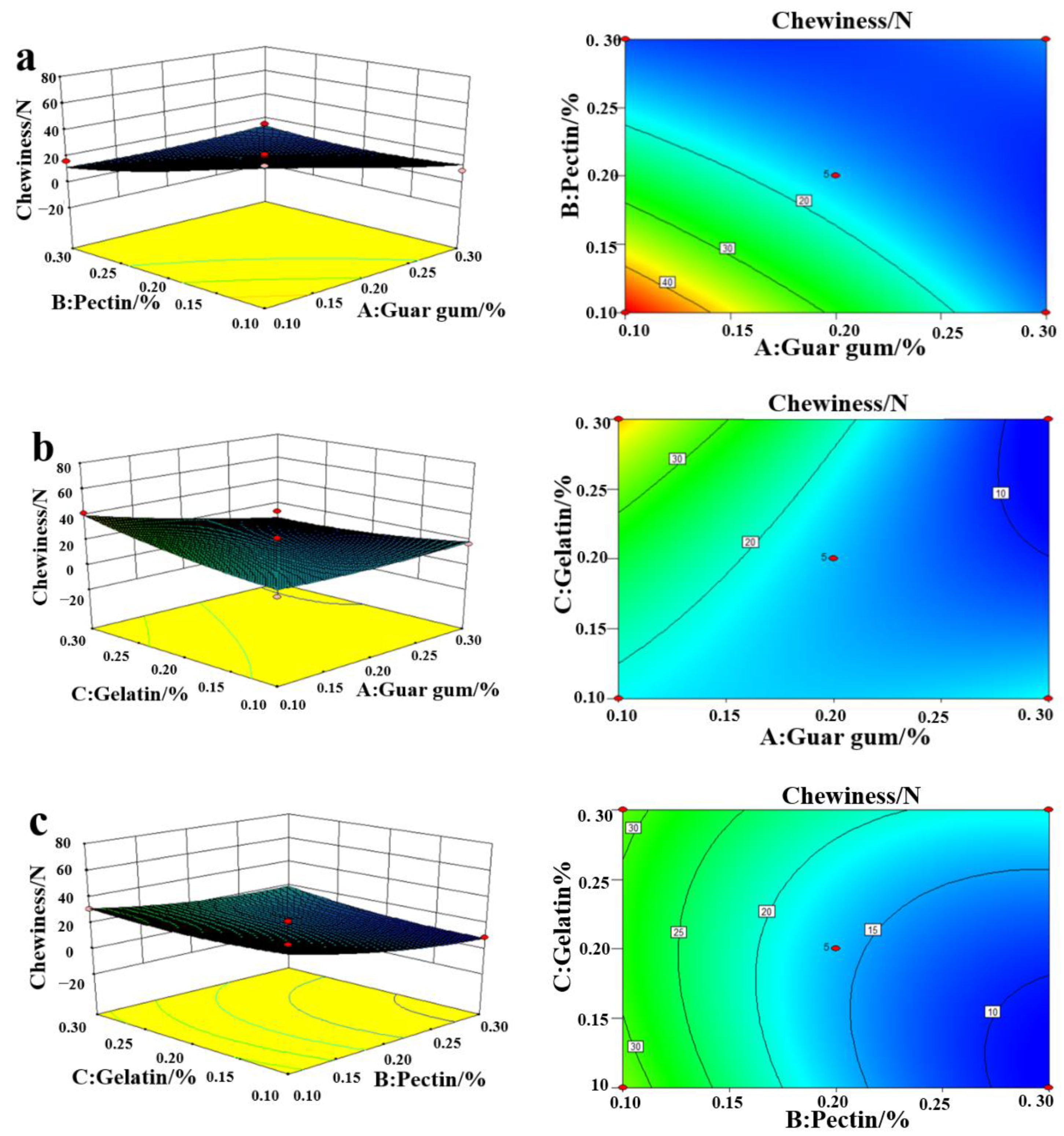
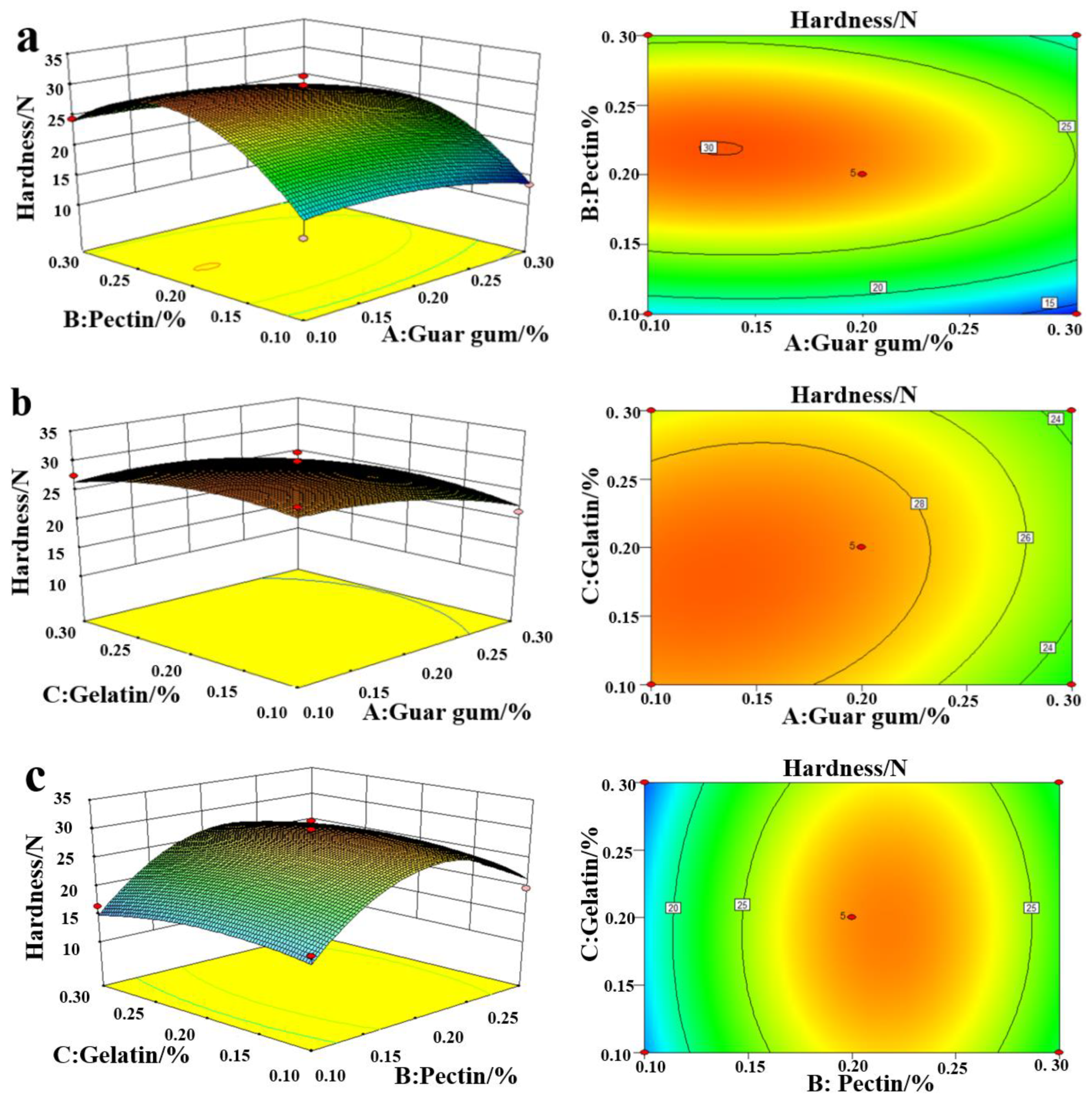

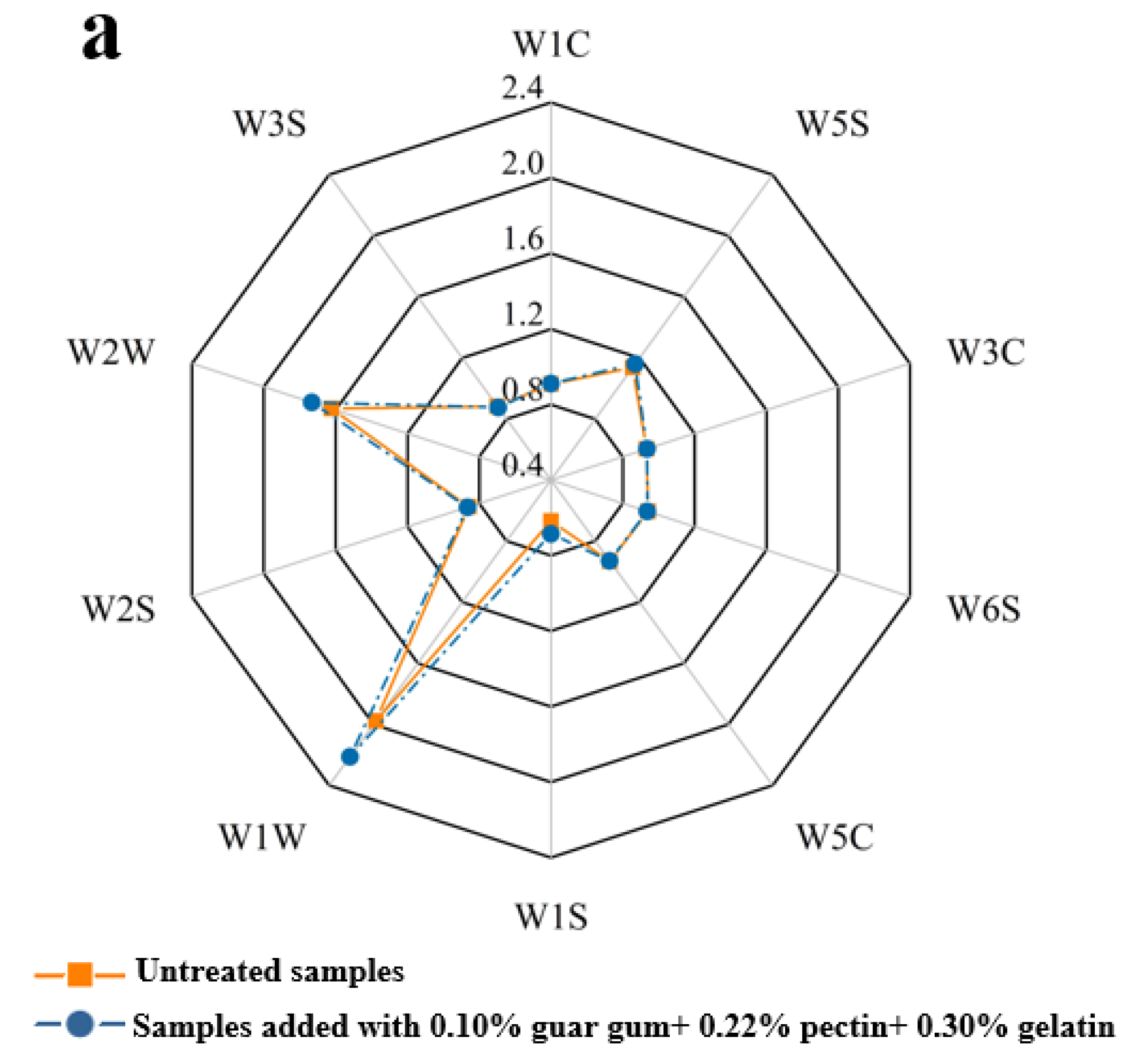

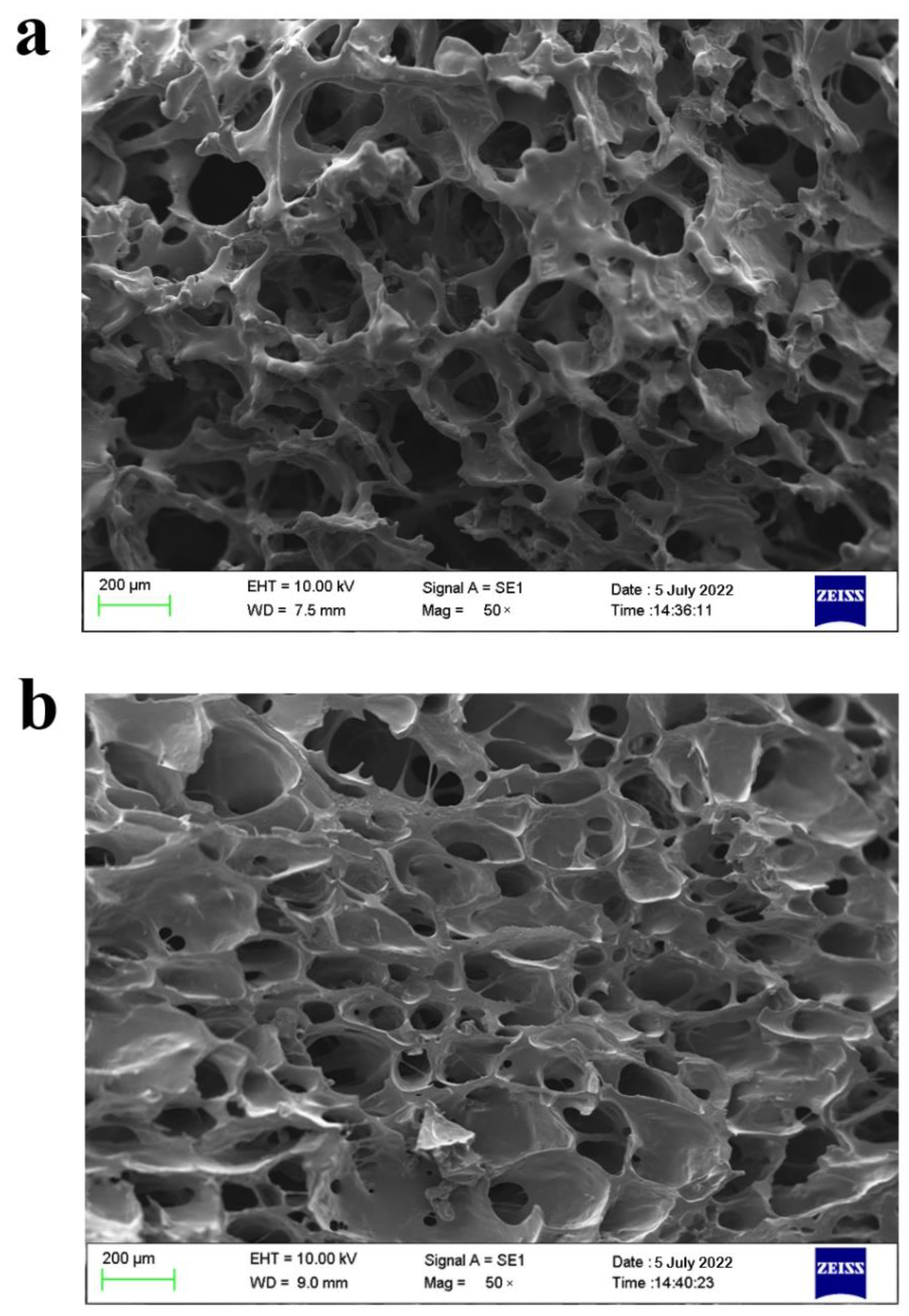
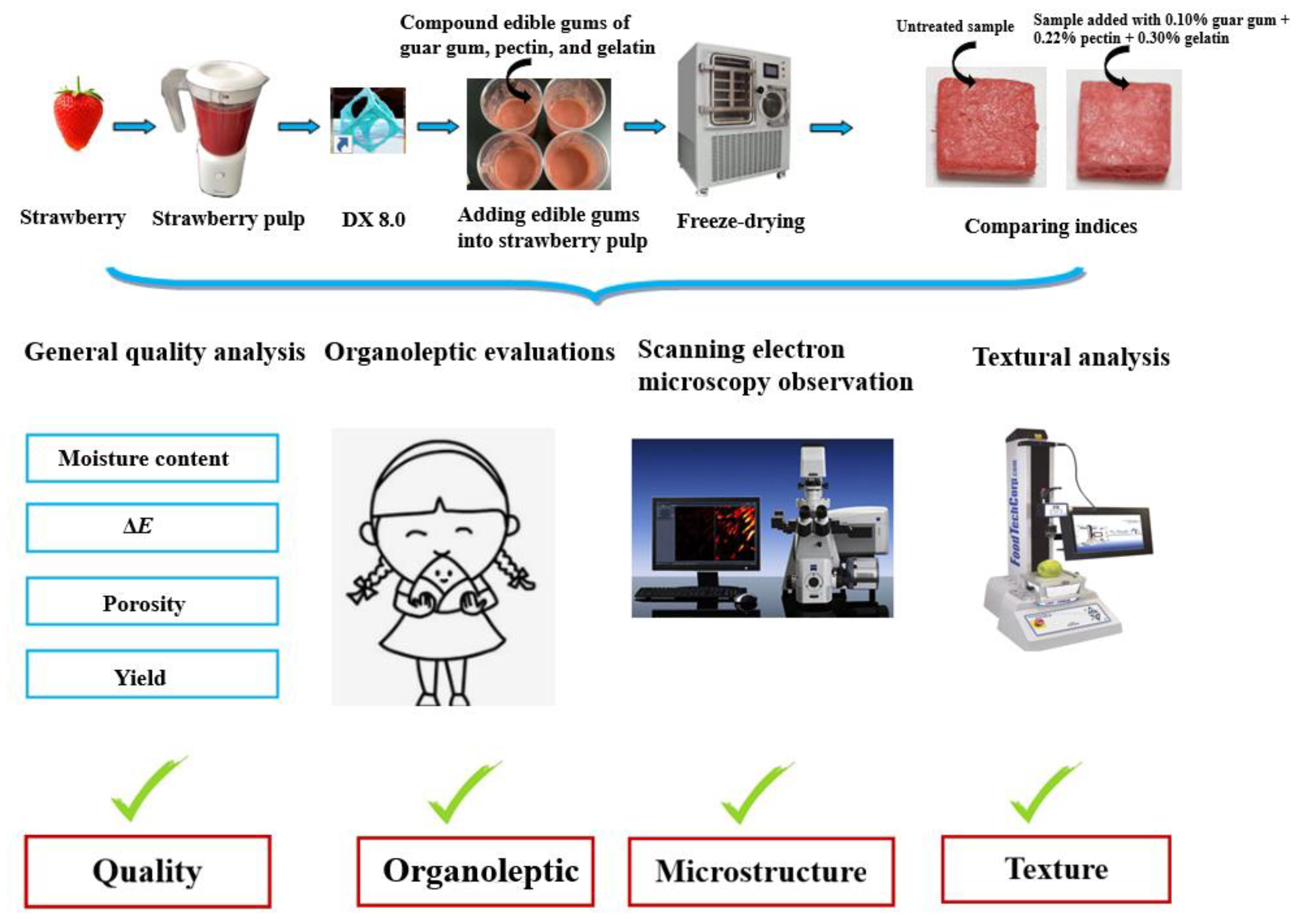
| Source | Chewiness | Hardness | Organoleptic Evaluations | |||||||
|---|---|---|---|---|---|---|---|---|---|---|
| DF | Sum of Squares | F-Value | p-Value | Sum of Squares | F-Value | p-Value | Sum of Squares | F-Value | p-Value | |
| Model | 9 | 1986.64 | 5.51 | 0.0174 * | 481.51 | 6.66 | 0.0102 * | 1.34 | 5.19 | 0.0205 * |
| A | 1 | 518.90 | 12.95 | 0.0087 * | 44.27 | 5.52 | 0.0512 | 0.12 | 4.19 | 0.0799 |
| B | 1 | 659.75 | 16.47 | 0.0048 * | 68.91 | 8.58 | 0.0220 * | 0.43 | 14.92 | 0.0062 * |
| C | 1 | 48.22 | 1.20 | 0.3089 | 0.94 | 0.12 | 0.7425 | 0.0066 | 0.23 | 0.6457 |
| AB | 1 | 334.34 | 8.35 | 0.0233 * | 0.90 | 0.11 | 0.7472 | 0.12 | 4.03 | 0.0846 |
| AC | 1 | 261.79 | 6.54 | 0.0377 * | 2.37 | 0.30 | 0.6036 | 0.0016 | 0.056 | 0.8200 |
| BC | 1 | 34.81 | 0.87 | 0.3823 | 0.29 | 0.036 | 0.8543 | 0.034 | 1.19 | 0.3107 |
| A2 | 1 | 16.39 | 0.41 | 0.5428 | 14.43 | 1.80 | 0.2218 | 0.31 | 10.69 | 0.0137 * |
| B2 | 1 | 61.69 | 1.54 | 0.2546 | 314.79 | 39.21 | 0.0004 * | 0.27 | 9.35 | 0.0184 * |
| C2 | 1 | 38.28 | 0.96 | 0.3608 | 15.55 | 1.94 | 0.2067 | 0.011 | 0.40 | 0.5467 |
| Residual | 7 | 280.39 | 56.19 | 0.20 | ||||||
| Lack of fit | 3 | 195.84 | 3.09 | 0.1523 | 31.24 | 1.67 | 0.3095 | 0.095 | 1.20 | 0.4171 |
| Pure error | 4 | 84.55 | 24.96 | 0.11 | ||||||
| Cor total | 16 | 2267.04 | 537.71 | 1.54 | ||||||
| Index | Untreated Samples | Samples Added with 0.10% Guar Gum + 0.22% Pectin + 0.30% Gelatin |
|---|---|---|
| Moisture content (%) | 4.00 ± 0.00 a | 4.80 ± 0.00 b |
| Yield (%) | 19.00 ± 0.12 a | 19.00 ± 0.15 a |
| Chewiness (N) | 6.50 ± 0.32 b | 36.20 ± 0.80 a |
| Hardness (N) | 19.30 ± 0.87 b | 26.47 ± 0.95 a |
| ΔE | 15.67 ± 0.22 a | 12.21 ± 0.89 b |
| Organoleptic evaluations | 7.03 ± 0.12 b | 8.10 ± 0.10 a |
| Total pore volume (mL/g) | 0.76 ± 0.05 b | 0.80 ± 0.07 a |
| Average pore diameter (nm) | 118.90 ± 1.16 b | 125.10 ± 0.93 a |
| Apparent density (g/mL) | 0.54 ± 0.04 b | 0.62 ± 0.03 a |
| Total pore area (m2/g) | 24.83 ± 0.04 b | 25.65 ± 0.12 a |
| Porosity (%) | 29.33 ± 0.25 b | 32.34 ± 0.74 a |
| Treatment Group | Guar Gum/% | Pectin/% | Gelatin/% | Chewiness/N | Hardness/N | Organoleptic Evaluations |
|---|---|---|---|---|---|---|
| 1 | 0.20 | 0.30 | 0.30 | 12.92 ± 0.75 | 19.95 ± 0.62 | 8.28 ± 0.05 |
| 2 | 0.10 | 0.30 | 0.20 | 16.73 ± 0.54 | 24.46 ± 0.76 | 8.05 ± 0.03 |
| 3 | 0.20 | 0.20 | 0.20 | 21.65 ± 0.83 | 28.87 ± 0.50 | 8.33 ± 0.02 |
| 4 | 0.20 | 0.20 | 0.20 | 14.26 ± 0.56 | 29.97 ± 0.48 | 7.93 ± 0.11 |
| 5 | 0.10 | 0.20 | 0.30 | 41.25 ± 0.87 | 27.52 ± 0.54 | 8.03 ± 0.05 |
| 6 | 0.20 | 0.10 | 0.30 | 31.15 ± 0.82 | 16.54 ± 0.68 | 7.51 ± 0.03 |
| 7 | 0.30 | 0.20 | 0.30 | 12.85 ± 0.73 | 21.81 ± 0.43 | 7.58 ± 0.01 |
| 8 | 0.20 | 0.10 | 0.10 | 8.98 ± 0.52 | 19.72 ± 0.60 | 8.08 ± 0.01 |
| 9 | 0.10 | 0.20 | 0.10 | 13.29 ± 0.73 | 30.12 ± 0.80 | 8.12 ± 0.03 |
| 10 | 0.30 | 0.10 | 0.20 | 8.93 ± 0.49 | 13.43 ± 0.24 | 7.63 ± 0.02 |
| 11 | 0.20 | 0.20 | 0.20 | 12.18 ± 0.62 | 31.42 ± 0.78 | 8.24 ± 0.04 |
| 12 | 0.20 | 0.20 | 0.20 | 12.21 ± 0.60 | 24.81 ± 0.92 | 8.15 ± 0.02 |
| 13 | 0.30 | 0.20 | 0.10 | 17.25 ± 0.89 | 21.33 ± 0.34 | 7.75 ± 0.04 |
| 14 | 0.20 | 0.10 | 0.10 | 39.01 ± 0.76 | 17.39 ± 0.28 | 7.68 ± 0.04 |
| 15 | 0.20 | 0.20 | 0.20 | 20.56 ± 0.24 | 29.77 ± 0.76 | 8.31 ± 0.01 |
| 16 | 0.30 | 0.30 | 0.20 | 15.02 ± 0.65 | 21.35 ± 0.87 | 7.63 ± 0.05 |
| 17 | 0.10 | 0.10 | 0.20 | 47.21 ± 0.78 | 14.64 ± 0.46 | 7.37 ± 0.02 |
| Sensor Serial Number | Sensor Model Name | Performance Description for Sensitive Substances |
|---|---|---|
| 1 | W1C | Aromatic, benzene |
| 2 | W3S | Sensitive to long-chain alkanes |
| 3 | W2W | Aromatic |
| 4 | W2S | Sensitive to alcohols, aldehydes and ketones |
| 5 | W1W | Sensitive to sulfides |
| 6 | W1S | Sensitive to methyl compounds |
| 7 | W5C | Broad range, sensitive to nitrogen oxides |
| 8 | W6S | Mainly selective to hydrides |
| 9 | W3C | Sensitive to aromatic and ammonia |
| 10 | W5S | Aromatic components of short-chain alkanes |
Publisher’s Note: MDPI stays neutral with regard to jurisdictional claims in published maps and institutional affiliations. |
© 2022 by the authors. Licensee MDPI, Basel, Switzerland. This article is an open access article distributed under the terms and conditions of the Creative Commons Attribution (CC BY) license (https://creativecommons.org/licenses/by/4.0/).
Share and Cite
Hu, J.; Sun, X.; Xiao, H.; Yang, F.; Liu, C.; Wang, H.; Zhang, H.; Zhang, W. Optimization of Conditions for a Freeze-Dried Restructured Strawberry Block by Adding Guar Gum, Pectin and Gelatin. Plants 2022, 11, 2809. https://doi.org/10.3390/plants11212809
Hu J, Sun X, Xiao H, Yang F, Liu C, Wang H, Zhang H, Zhang W. Optimization of Conditions for a Freeze-Dried Restructured Strawberry Block by Adding Guar Gum, Pectin and Gelatin. Plants. 2022; 11(21):2809. https://doi.org/10.3390/plants11212809
Chicago/Turabian StyleHu, Jiaqi, Xiyun Sun, Hongwei Xiao, Feifei Yang, Chunju Liu, Haiou Wang, Honglin Zhang, and Wei Zhang. 2022. "Optimization of Conditions for a Freeze-Dried Restructured Strawberry Block by Adding Guar Gum, Pectin and Gelatin" Plants 11, no. 21: 2809. https://doi.org/10.3390/plants11212809
APA StyleHu, J., Sun, X., Xiao, H., Yang, F., Liu, C., Wang, H., Zhang, H., & Zhang, W. (2022). Optimization of Conditions for a Freeze-Dried Restructured Strawberry Block by Adding Guar Gum, Pectin and Gelatin. Plants, 11(21), 2809. https://doi.org/10.3390/plants11212809






